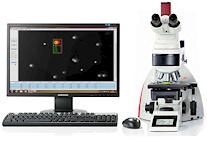Combination antiretroviral therapy (cART) & comet assay
- Details
- Created: Tuesday, 18 April 2017 09:24
An international collaboration of scientists from Brazil and Italy have produced a recent publication entitled: “Antiretroviral Therapy Initiation Alters the Redox System of Asymptomatic HIV-Infected Individuals: A Longitudinal Study”. It was stated in the paper that the combination antiretroviral therapy (cART) increases the oxidative stress in HIV-infected people, which in turn favours the onset and aggravation of non-AIDS comorbidities, a common situation affecting these individuals.
The publication also discussed how there is increasingly early recommendation for therapeutic treatment beginning in HIV-infected people, a strategy to promote benefits in patients and to reduce transmission rates. However, due to prolonged use of cART, its toxic effects should be taken into account. In addition to kidney, liver, and bone impairment, many drugs are responsible for the onset of the metabolic syndrome and consequently for the increase of non-AIDS comorbidities, what could be contributing to current causes of death in this population such as cardiovascular disease and diabetes mellitus, among others. For references regarding this information, please refer to the original publication.
The investigators aimed to evaluate the influence of cART initiation on oxidative stress parameters.
They conducted a longitudinal study including 30 asymptomatic patients divided according to their CD4+ T cell count (G1: <500 cell/mL; G2: >500 cell/mL) before (M0) and after (M1) cART initiation.
 The scientists analysed total antioxidant capacity (TAC), fat-soluble vitamins, malondialdehyde, 8-isoprostane, and DNA damage. Analysis of DNA damage in peripheral blood mononuclear cells was performed by comet assay using 30 μL of whole blood set on a blade with agarose. After lysis solution treatment, triplicates of the blades were subjected to three different conditions in electrophoresis: basal condition (BAS), formamidopyrimidine DNA glycosylase (FPG), or endonuclease III (END) addition for detection of oxidative damage in purine and pyrimidine bases. The slides were stained by Sybr Gold. Using an immunofluorescence microscope connected to an image analysis system (Comet Assay IV, Perceptive Instruments - An Instem Company) a total of 50 randomly selected nucleoids were counted for each slide. Results were expressed as tail intensity, which is the percentage of migrated DNA, and tail moment, relative values from the fraction of migrated DNA multiplied for the length of the tail. For full experimental details, please refer to the original publication.
The scientists analysed total antioxidant capacity (TAC), fat-soluble vitamins, malondialdehyde, 8-isoprostane, and DNA damage. Analysis of DNA damage in peripheral blood mononuclear cells was performed by comet assay using 30 μL of whole blood set on a blade with agarose. After lysis solution treatment, triplicates of the blades were subjected to three different conditions in electrophoresis: basal condition (BAS), formamidopyrimidine DNA glycosylase (FPG), or endonuclease III (END) addition for detection of oxidative damage in purine and pyrimidine bases. The slides were stained by Sybr Gold. Using an immunofluorescence microscope connected to an image analysis system (Comet Assay IV, Perceptive Instruments - An Instem Company) a total of 50 randomly selected nucleoids were counted for each slide. Results were expressed as tail intensity, which is the percentage of migrated DNA, and tail moment, relative values from the fraction of migrated DNA multiplied for the length of the tail. For full experimental details, please refer to the original publication.
In relation to the comet assay, the publication reports that there was a slight increase, although not significant, for the tail moment and tail intensity relative to slides treated with END in M1 compared to M0. However, when analyses were performed considering the G1 and G2 groups, the investigators observed an increase in DNA damage only in G2, at the tail moment of the blades treated with FPG and END, and in the tail intensity of the blades treated with END.
Taking the study as a whole, results showed a decrease in TAC, retinol, α-tocopherol, and some carotenoids, in addition to a significant increase in DNA damage at M1. These changes were more evident in G2 subjects. Moreover, there was a significant 8-isoprostane increase at M1 in individuals belonging to G1.
The results from this investigation led the researchers to conclude that cART interfered in the redox system, mainly by reducing the antioxidant defenses. In addition, patients who had CD4+ T counts higher than 500 cells/mm3 showed more susceptibility to genotoxicity, while patients with less CD4+ T counts displayed more damage triggered by lipoperoxidation. Considering the early beginning of cART, its chronic use, and its capacity to alter the redox status, the investigators believe that further long-term studies on larger cohorts are needed to define the best time to initiate therapy and to investigate new strategies to delay the development of non-AIDS diseases.
Original publication
Antiretroviral Therapy Initiation Alters the Redox System of Asymptomatic HIV-Infected Individuals: A Longitudinal Study. Oxidative Medicine and Cellular Longevity, vol. 2017, Article ID 9834803, 10 pages, 2017. Karen Ingrid Tasca, Juliana Trindade Caleffi, Camila Renata Correa, et al.,
